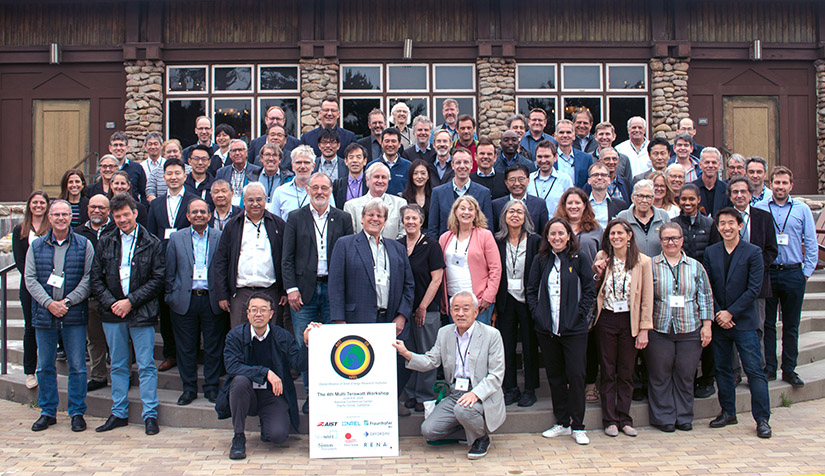International Solar Energy Leaders, Researchers Discuss Growing Role in World Energy and Shared Challenges for the Future at 4th Multiterawatt Workshop

Approximately 70 researchers from 14 countries gathered in California earlier this month to discuss the progress toward deploying multiple terawatts of solar power around the globe to transition to a sustainable energy system. Representatives of the U.S. Department of Energy’s National Renewable Energy Laboratory (NREL) held high-level discussions with international colleagues about the state of the photovoltaics (PV) industry.
This year marked the 4th Terawatt Workshop, led by representatives from NREL, Germany’s Fraunhofer Institute for Solar Energy Systems, and Japan’s National Institute of Advanced Industrial Science and Technology.
Except for a gap during COVID-19, the Terawatt Workshop has met every two years since 2016. That first meeting addressed the challenge of reaching 3 TW of installed global PV capacity by 2030. The participants extended that vision at the 2018 meeting, to about 10 terawatts, and predicted the global cumulative PV capacity would reach a terawatt within the next five years. The world crossed that threshold in 2022.
“The tremendous learning curve in PV over the past decades has resulted in continuous technology advances, major cost reductions, and deployment growth often exceeding predictions,” said Nancy Haegel, the director of the National Center for Photovoltaics at NREL. “The workshop participants were very engaged in learning from one another and discussing what the growth and learning of the next decade could bring.”
She was joined at the conference by six colleagues from NREL: Teresa Barnes, Emily Warren, Kirstin Alberi, Joe Berry, Ingrid Repins, and Samantha Reese.
The workshop opened with reports and discussion of PV growth trajectories and challenges around the world, with a focus on India, Europe, China, the United States, Australia, and Kenya. This “trip around the globe” highlighted both the regional opportunities and challenges to PV growth and its contributions to meeting carbon dioxide emission reduction goals. A growing number of future scenarios shows PV playing major roles in helping countries move to a sustainable energy system.
“PV technology has demonstrated increasingly great success and has become a mainstream for the world energy supply. However, more research is needed in order to push the efficiency even higher and to create a circular economy,” said Andreas Bett, director of the Fraunhofer Institute for Solar Energy Systems. “PV is well on track to provide the majority of the world’s energy in a cost-effective, clean, and sustainable way.”
During the workshop, participants discussed PV technology innovation for the multiterawatt era, with a focus on tandem technology, which promises to significantly extend PV efficiency beyond existing limits. Tandem technologies combine two types of solar cells into one device, allowing increased absorption of light from the sun. Major research is underway, but there are still challenges remaining to achieve industrial production of a higher efficiency, reliable tandem technology for terrestrial power production. The workshop heard from leading researchers and industry partners on their progress and challenges in this area.
Another key topic was the issue of long-term sustainability and circularity for the industry, as it moves toward future steady-state production, installation, and replacement at multiterawatt scale heading toward 2050. Workshop participants agreed that the increased production is bringing a new set of research and development challenges to the PV community. Targeted research is needed to drive innovation and support industry efforts to continue to reduce levels of embedded energy and carbon and raw material use, while leveraging global learning and growing diversification of manufacturing to also continue to advance performance and reliability.
Just as the PV industry has advanced and grown to lead the way on renewable energy in 2024, with the majority of new electricity generating capacity worldwide each year now coming from solar, it is preparing for the transition to its role to provide a majority of the world's energy needs.
The participants from the 2022 workshop suggested that about 75 terawatts or more of globally deployed PV will be needed by 2050 to meet decarbonization goals.
The National Institute of Advanced Industrial Science and Technology focuses on the creation and practical realization of technologies useful to Japanese industry and society and on bridging the gap between innovative technological seeds and commercialization. The Fraunhofer Institute for Solar Energy Systems stands out as the largest solar energy research institute in Europe.
NREL is the only Department of Energy national laboratory exclusively devoted to research and analysis into renewable energy and sustainable energy technologies. Within the PV programs, researchers support the development of new designs and manufacturing processes for solar materials, components, and systems, with an emphasis on improved performance, reliability, and service life.
Learn more about solar energy and photovoltaic research at NREL.

